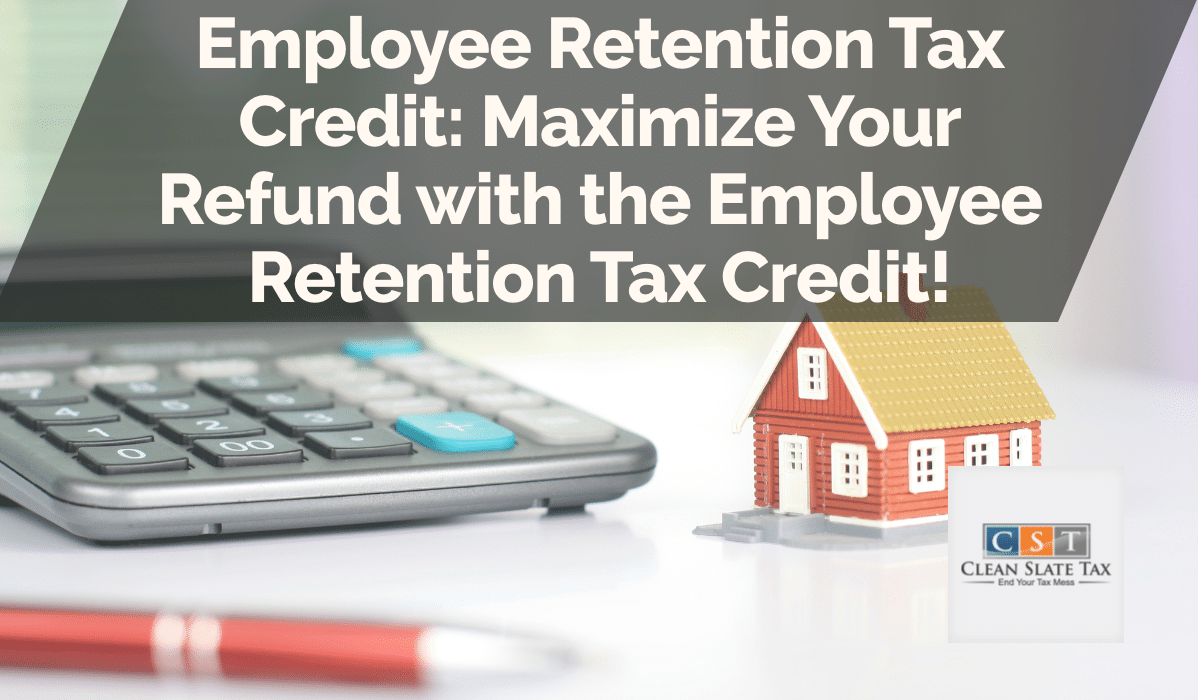Maximize Your Refund with the Employee Retention Tax Credit (ERTC)!

Get a Free Consultation on the Retention Tax Credit from one of our Tax Professionals – Get Tax Help Now!
Click Here To Get Started
- The Employee Retention Tax Credit (ERTC) is a refundable tax credit designed to incentivize employers, including corporations, startups, and firms, to retain employees amidst challenging economic circumstances such as the COVID-19 pandemic. It was introduced as part of the Coronavirus Aid, Relief, and Economic Security (CARES) Act.
- Companies can benefit from the ERTC. To qualify, a business must have experienced either a full or partial shutdown due to a government order related to COVID or a significant decline in gross receipts during the calendar quarter.
- The credit amount is calculated as a percentage of up to a certain amount of qualified wages an employer pays employees. For 2021, the credit was equal to 70% of the first $10,000 in wages and health benefits paid per employee for the first two quarters. However, as the IRS updates guidelines periodically, checking the IRS website or consulting with a tax professional for current regulations is recommended.
- The benefits of claiming the ERTC can be substantial. It provides immediate cash flow to employers by reducing their payroll tax liability, and if the credit amount exceeds the total payroll tax owed, the excess is refundable.
- The application process involves reporting the total qualified wages and related health insurance costs on your quarterly employment tax return (IRS Form 941). The IRS requires specific documentation to support your claim, including records of how your business meets the eligibility requirements.
- The deadline for claiming the ERTC varies depending on your tax filing schedule. It’s advisable to file your claim as soon as possible to avoid missing the deadline.
- Despite its benefits, the ERTC does have limitations. It does not apply to all wages, and stipulations are based on the company’s size and the extent of their economic hardship. Also, employers cannot claim the ERTC for salaries paid to employees if they are using the same wages to calculate other tax credits.
- Using the ERTC can support a team to keep working, helping businesses maintain their workforce or division and thus their services during difficult times. By taking advantage of the ERTC, companies like Colorado and elsewhere can ensure that their employees feel valued and retained, fostering a more stable work environment and group cohesion.
- Remember that understanding and navigating tax credits and regulations can be complex. Therefore, it’s recommended that you consult with a tax professional or a firm like Clean Slate Tax to ensure you’re maximizing your benefits and adhering to all guidelines.
How to Qualify for the Employee Tax Credit
This guide will explore the ERTC, offering insights into qualifications, benefits, limitations, calculation, and optimization.
Benefits and Limitations
- Offers tax relief to businesses that retain employees during periods of financial disruption.
- It can be claimed quarterly, adding substantial savings to a company’s bottom line.
- However, it is subject to qualification rules that might exclude certain businesses.
- It is also non-refundable, implying that a business can only offset its tax liability and not receive a refund above this amount.
Calculating the Potential Savings
- It depends on employee numbers, wages, and eligible expenses.
- Calculate to optimize potential savings accurately.
Determining Eligible Expenses
- Eligible expenses generally include salaries, health plan costs, and certain overhead expenses.
- Having understanding what counts as eligible expenses is crucial in maximizing tax savings.
Maximizing Your Tax Savings
- Ensuring all eligible expenses are reported can significantly maximize tax savings.
- Also, properly documenting these expenses can lead to increased savings.
Common Mistakes to Avoid When Claiming
- Common errors include misunderstanding eligibility criteria and miscalculating potential savings.
- Failing to document eligible expenses properly can lead to missed opportunities or potential disputes with tax authorities.
Understanding the Application Process
- The process involves gathering required documentation, accurately calculating the credit, and completing the correct IRS forms.
- It requires understanding the tax law, ensuring all eligibility criteria are met, and following the IRS guidelines for credit claims.
Navigating the ERTC: Tips for a Successful Application Process
- Preparing well in advance and understanding the tax laws can ensure a smooth application process.
- Seeking professional tax advice can help you navigate the complexities and optimize your tax savings.
Strategies for Optimizing Your ERTC
- Optimizing the ERTC involves strategic planning, diligent record-keeping, and ensuring all eligible expenses are claimed.
- Employing professional tax services or software can help manage this process and maximize your credit.
Expert Summary And Tips On The ERTC
- The ERTC is a federal initiative designed to incentivize businesses to keep their staff during challenging economic situations like the COVID-19 pandemic.
- Qualified employers can claim a refundable tax credit against certain employment taxes for wages paid to eligible employees.
- To be eligible for this credit, businesses must have either had their operations fully or partially suspended due to government directives limiting commerce, travel, or group gatherings or experienced a substantial drop in gross income compared to the corresponding quarter of the previous year.
- The cap for qualified wages used for the tax credit calculation is $10,000 per employee per quarter, potentially leading to a $5,000 tax credit per employee.
- Qualified wages encompass monetary compensation and specific health plan costs paid by employers on behalf of their eligible employees.
- Companies with 100 or fewer full-time employees generally qualify for the credit, regardless of the extent of the suspension of their business operations due to government restrictions. Only wages paid during the suspension periods are eligible for the credit for larger businesses.
- Self-employed persons are not eligible for this tax credit, but they might qualify for other relief options, such as expanded unemployment benefits under different schemes.
